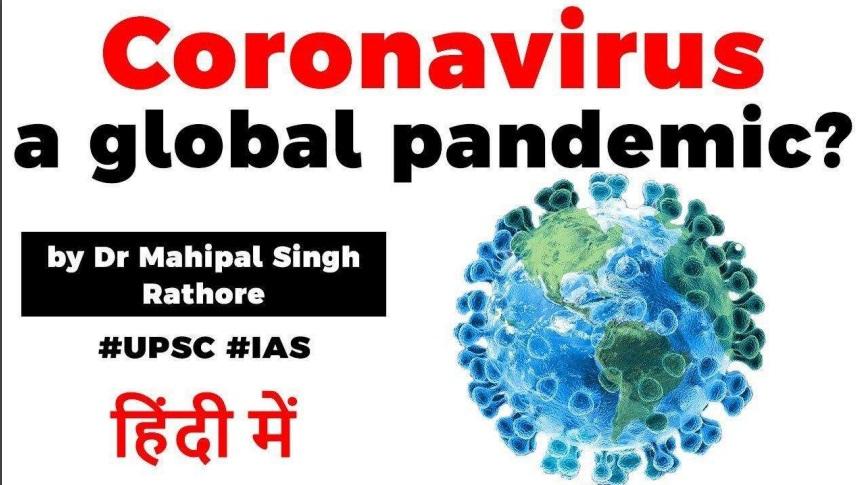Table of Contents

- The COVID-19 that emerged in Wuhan, China, in December 2019, is now in at least 47 countries around the world, spanning every continent except Antarctica.
- More than 82,000 people have been infected, and over 2,800 are dead.


Status on 28 February 2020
- On 27th Feb , China reported 329 cases – the lowest in more than a month.
- Outside China, there are now 4351 cases in 49 countries, and 67 deaths.
- 24 cases have been exported from Italy to 14 countries, and 97 cases have been exported from Iran to 11 countries.
The NAME
- The Disease – Coronavirus disease (COVID-19)
- The Virus –
- Severe acute respiratory syndrome coronavirus 2
- (SARS-CoV-2)
- Pandemic, Epidemic and Outbreak
- Outbreak – A sudden rise in the cases of a disease in a particular place.
- Epidemic – A large outbreak among a particular population or region.
- Pandemic – The worldwide spread of a disease
Pandemic
- A pandemic is an epidemic occurring on a scale which crosses international boundaries, usually affecting a large number of people
- Pandemics can also occur in important agricultural organisms (livestock, crop plants, fish, tree species) or in other organisms
Example of a pandemic
- Throughout history, there have been a number of pandemics, such as smallpox and tuberculosis.
- One of the most devastating pandemics was the Black Death, which killed an estimated 75–200 million people in the 14th century.
- The only current pandemic is HIV/AIDS, which started in the 1980s.
- Other recent pandemics are the 1918 influenza pandemic (Spanish flu) and the 2009 flu pandemic (H1N1)
Isn’t Coronavirus a pandemic already?
- On January 30, 2020, the International Health Regulations Emergency Committee of the WHO declared the outbreak a “public health emergency of international concern’’
- WHO has not labelled COVID 19 as a pandemic yet.
- WHO looks for sustained outbreaks causing a larger-thanexpected number of cases on multiple continents.
- There is no specific number of countries that a disease must touch for WHO to classify it as a pandemic.
- The new Coronavirus is still being called an epidemic – linked epidemics of COVID-19 in several countries.
- In June 2009, the WHO declared a global pandemic of novel influenza A (H1N1), commonly known as swine flu.
- The WHO has abandoned that system of classification now, even though the term pandemic can still be used “colloquially”.
- What does CDC say?
- The US Centers for Disease Control and Prevention says the covid-19 virus already meets two of its three criteria for a pandemic:
- it spreads between people
- it kills.
- The third is that it has to spread worldwide.
- WHO doesn’t see evidence as yet that the virus is spreading freely in communities worldwide .
- Response to Pandemic
- There are two kinds of response to a growing pandemic.
- The first is containment: as cases appear, you can isolate each person then trace and quarantine their contacts. That worked for SARS and the 2014-2016 Ebola outbreak.
The second is mitigation –
- If containment only slows the virus, eventually you get “community spread”: people are infected without knowing how they were exposed, so you can’t quarantine all contacts. slow the epidemic so it won’t peak massively and quickly, overloading health facilities. close schools, cancel mass gatherings, shut down whole cities when they have community spread.
Precautions all over the world
- Japan is closing all its schools for 1.3 crore children till April. China already did it for 20 crore students.
- Saudi Arabia – stopping foreign pilgrims entering the country.
- Tokyo Olympics ‘could’ be cancelled.
- Australia – ban on foreign visitors from mainland China.
- Iran has cancelled Friday prayers in Tehran 6. Italy has quarantined 11 towns.
- Greece is cancelling all carnival activities. 8. San Francisco has declared emergency

What is being done?
- The key to containing this virus is to break the chains of transmission
- If robust action is taken to detect cases early, isolate and care for patients and trace contacts.
- More than 20 vaccines are in development globally, and several therapeutics are in clinical trials.
- Expect the first results in a few weeks.
How to protect yourself ?
- Respiratory viruses, like those that cause colds, flu, and pneumonia, spread mainly through coughs, sneezes and direct contact with infected people. In most such cases, the transmission of the virus happens only after an infected person has developed the symptoms.


Practice respiratory hygiene
- When coughing and sneezing, cover mouth and nose with flexed elbow or tissue – discard tissue immediately into a closed bin and clean your hands with alcohol-based hand rub or soap and water.
- Why? Covering your mouth and nose when coughing and sneezing prevent the spread of germs and viruses.
- If you sneeze or cough into your hands, you may contaminate objects or people that you touch.
Maintain social distancing
- Maintain at least 1 metre (3 feet) distance between yourself and other people, particularly those who are coughing, sneezing and have a fever.
- Why? When someone who is infected with a respiratory disease, like covid-2019, coughs or sneezes they project small droplets containing the virus. If you are too close, you can breathe in the virus

Latest Burning Issues | Free PDF
























 WhatsApp
WhatsApp